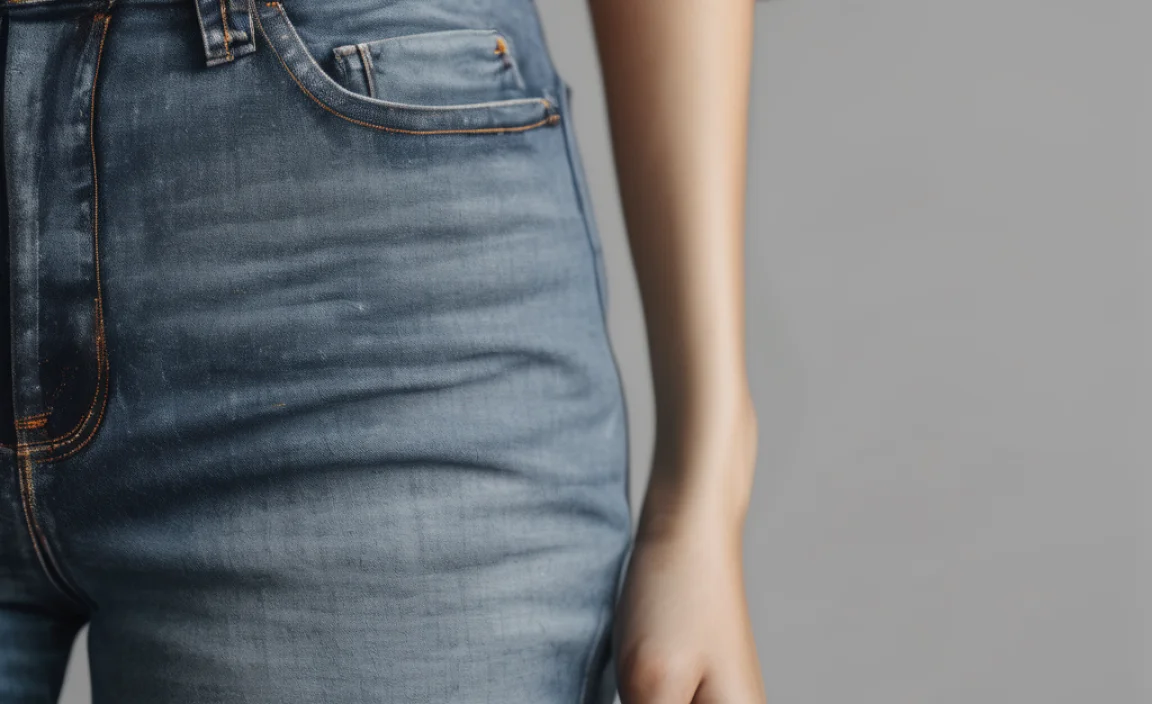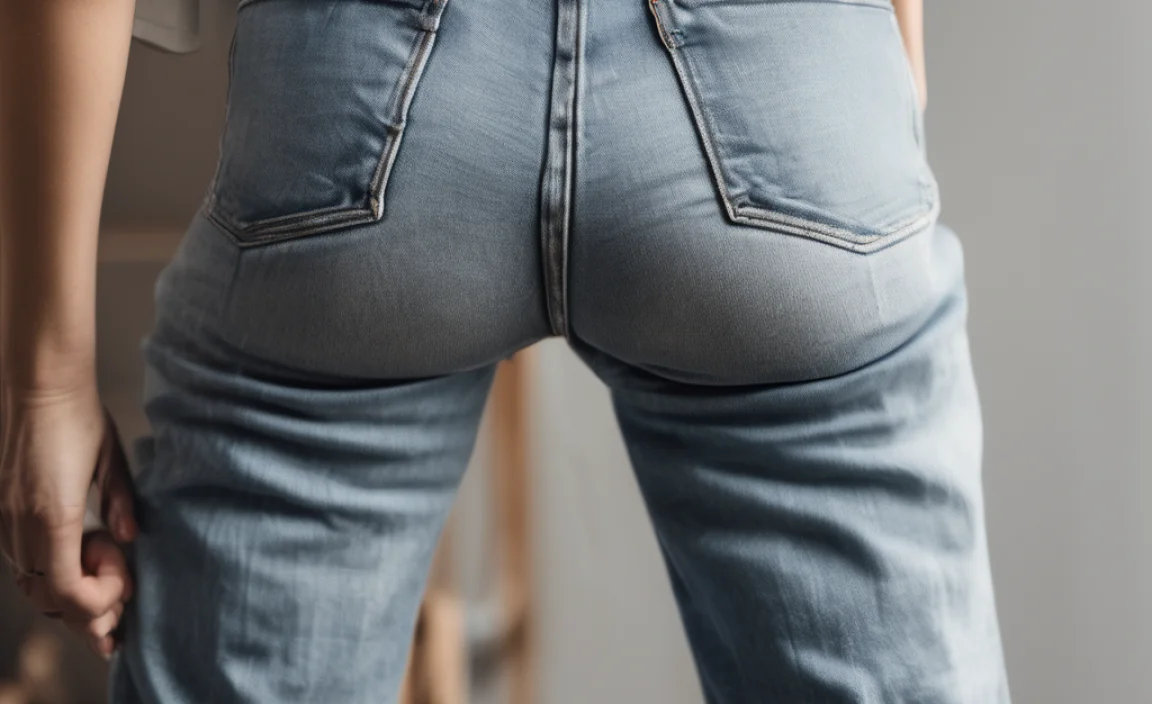Quick Summary
Mastering how to hem mom jeans at home is a straightforward DIY project. This guide provides clear, step-by-step instructions and essential tips to achieve a professional-looking finish, ensuring your favorite jeans fit perfectly without a trip to the tailor.
How to Hem Mom Jeans: An Essential DIY Guide
Mom jeans are a beloved wardrobe staple, but their often relaxed fit can sometimes translate to a leg opening that’s just a bit too long. Before you reach for scissors or plan an expensive tailoring appointment, discover how easy it is to hem mom jeans yourself. This guide is designed to make the process simple, even if you’ve never sewn before. We’ll walk you through everything you need, from measuring to the final stitch, so your jeans fit just right.
Fret not if your favorite pair of mom jeans are a tad too long. Many of us find ourselves with denim that doesn’t quite hit the mark in terms of length. This common wardrobe issue can make even the coolest jeans feel a bit sloppy. The good news is you don’t need to be a sewing expert to fix it. With a few basic tools and this easy-to-follow guide, you can achieve a perfect hem at home. Let’s get your mom jeans looking and feeling fantastic!
Why Hem Your Mom Jeans?

There are several compelling reasons to consider hemming your mom jeans. Often, their iconic relaxed fit comes with a slightly longer inseam, which can overwhelm your frame, pool around your ankles, or simply not sit right with your chosen footwear. Achieving the ideal length can dramatically change how a pair of jeans looks on you, making them more versatile and flattering.
- Perfect Fit: The most obvious reason is to achieve the perfect inseam length. This ensures your jeans sit beautifully with your favorite shoes, whether sneakers, boots, or heels.
- Streamlined Silhouette: A proper hem can create a cleaner, more polished silhouette, preventing the hem from bunching or dragging.
- Style Customization: You might want to create a cropped look to take advantage of warmer weather or to showcase a particular pair of shoes.
- Cost Savings: DIY hemming is significantly cheaper than paying a tailor, especially if you plan to alter multiple pairs.
- Salvaging Great Jeans: It’s a way to give new life to jeans that are otherwise perfect in fit and style but simply too long.
Essential Tools and Materials

Gathering the right supplies before you start will make the hemming process smooth and efficient. You don’t need a professional sewing machine; many of these steps can be done by hand. Here’s what you’ll need:
- Your mom jeans
- Fabric scissors (sharp ones are key!)
- Measuring tape
- Fabric chalk or a washable pen
- Straight pins
- Thread (matching your jeans color)
- Sewing needle (if hand-sewing) or sewing machine
- Iron and ironing board
- Optional: Hemming tape (for a no-sew option)
Step-by-Step Guide: How to Hem Mom Jeans

This guide covers the most common and effective method for hemming jeans, ensuring a durable and neat finish. We’ll focus on preserving the original hem look where possible, as this is often a desired aesthetic for mom jeans.
Step 1: Try Them On and Determine the Desired Length
Start by putting on the mom jeans. Wear the shoes you typically plan to wear with them. Stand in front of a mirror and decide where you want the hem to fall. Use a pin or fabric chalk to mark the desired length on one leg. It’s crucial to do this while wearing the jeans to get the most accurate measurement.
Step 2: Measure from the Crotch
Once you’ve marked the desired length, take off the jeans. Lay them flat on a table or the floor. Measure the inseam from the crotch seam down to the mark you just made. This measurement is your target inseam length. Double-check with your measuring tape.
Step 3: Mark the Cut Line
Now, you need to decide how much excess fabric to cut. It’s generally recommended to leave about 1-1.5 inches of extra fabric below your desired finished hemline for a standard hem. This extra fabric will be folded up to create the new hem. Use your fabric chalk or washable pen to draw a straight line across the leg, 1-1.5 inches above your marked desired length. Repeat this on the other leg, ensuring it’s at the exact same measurement from the crotch to maintain symmetry.
Step 4: Cut the Excess Fabric
Put on your denim gloves if you want extra grip, and grab your sharp fabric scissors. Carefully cut along the chalk line you marked on both legs. Ensure you cut as straight as possible. If you’re nervous about cutting, you can always cut a little less and trim more later. For a truly professional finish that mimics the original hem, consider a more advanced technique where you detach and reattach the original hem. However, for a straightforward DIY, cutting and re-hemming is perfectly effective.
Step 5: Prepare the New Hem
Take one leg and fold the raw edge up by about half an inch towards the inside of the jean. Press this fold firmly with an iron. Then, fold it up again by another inch (or enough to encompass your desired hem allowance). This creates a double-folded hem, which is sturdy and prevents fraying. Press this second fold with the iron to create crisp creases. Pin the hem in place all the way around the leg to secure the fold.
Step 6: Stitch the Hem
This is where you’ll sew the hem.
Option A: Hand Sewing
Thread your needle with matching thread, knotting the end securely. Use a strong stitch like a backstitch or a hemming stitch (also known as a blind stitch if you want it to be less visible from the outside) to sew along the inner edge of the folded hem. Aim to catch just a few threads of the main jean fabric on each stitch to keep the stitches as inconspicuous as possible from the outside layer. Continue sewing all the way around the leg, removing pins as you go. Knot the thread securely at the end.
Option B: Machine Sewing
Set up your sewing machine with a sturdy needle (denim needles are best) and matching thread. Select a straight stitch. Start sewing at the inseam of the hem, backstitching a few stitches to secure. Sew all the way around the leg, keeping the raw edge of the hem tucked neatly within the fold. You may want to remove the leg from the machine and flatten the fabric to make it easier to sew over thicker seams. Backstitch again at the end to secure.
Step 7: Finishing Touches
Once both legs are hemmed and stitched, trim any loose threads. Give the hemmed area a final press with the iron to ensure it lays flat and looks sharp. Try on your perfectly hemmed mom jeans!
No-Sew Hemming Option with Hemming Tape

If you don’t have a sewing machine or prefer a quicker, no-sew method, hemming tape (also known as fusible web or hem tape) is an excellent alternative. It’s surprisingly strong and can provide a clean finish.
- Prepare the Jeans: Follow Steps 1-4 above to determine your desired length and cut off the excess fabric, leaving your 1-1.5 inch hem allowance.
- Prepare the Hem: Fold the raw edge up by about half an inch towards the inside of the leg and press with an iron. Then, fold it up again by the remaining allowance (e.g., 1 inch) to create your double-folded hem. Press this second fold firmly.
- Insert Hemming Tape: Unfold the second fold only (leaving the first half-inch fold in place). Cut a piece of hemming tape to fit the length of the hem allowance. Place the hemming tape inside the fold, against the raw edge of the fabric.
- Fuse the Tape: Carefully refold the outer edge of the hem down over the hemming tape, ensuring it covers the tape completely. Follow the manufacturer’s instructions for your specific hemming tape, but generally, you’ll use a hot iron (without steam) to press over the taped hem. Hold the iron in place for the recommended time (usually 10-15 seconds per section). The heat will melt the adhesive in the tape, bonding the fabric layers together.
- Cool and Check: Allow the hem to cool completely before checking that it’s securely fused. Repeat on the other leg.
Tip: For a stronger no-sew hem, you can apply the hemming tape to the first fold, then fold the fabric up and press. This creates a single-fold hem secured by tape. While less traditional, it can work well for casual denim.
Preserving the Original Hem Look

For a truly authentic mom jean look, especially if your jeans have a “distressed” or “worn” hem with frayed edges, simply cutting and re-hemming might not fully replicate the original aesthetic. In this case, you might want to detach the original hem and reattach it to the newly shortened leg. This is a more advanced technique.
Detaching and Reattaching the Original Hem
- Mark and Cut: Decide on your desired length and mark it. Instead of cutting off the excess, carefully detach the original hem. You’ll need to unpick the stitches holding the original hem to the leg of the jeans. Do this meticulously to avoid damaging the fabric. You should end up with a long strip of denim (the original hem) and the shortened leg.
- Prepare the Leg: Fold up the raw edge of the shortened leg to the length you want your final hem to be. Press it firmly.
- Reattach the Original Hem: Align the original hem strip to the bottom of the shortened jean leg, matching raw edges. Pin securely.
- Sew: Hand-sew or machine-sew the original hem back onto the leg. The goal is to make the stitches as invisible as possible by sewing from the inside, catching the original stitches’ path.
Table: Hemming Techniques Compared
Choosing the right hemming method depends on your skill level, desired look, and available tools. Here’s a quick comparison:
| Technique | Pros | Cons | Skill Level | Best For |
|---|---|---|---|---|
| Sewn Hem (Double Fold) | Durable, clean finish, professional look, strong. | Requires sewing skills (hand or machine), takes more time. | Beginner to Intermediate | Most jeans, creating a clean, classic hem. |
| No-Sew Hem (Hemming Tape) | Quick, easy, no special skills needed, invisible from outside. | Can be less durable over time, might not hold up to heavy washing, can sometimes look stiff. | Beginner | Quick fixes, casual wear, when a sewing machine isn’t available. |
| Preserving Original Hem | Authentic look, retains original distressing/finish, professional tailor-like result. | Very time-consuming, requires precision and patience, higher risk of error. | Intermediate to Advanced | Jeans with specific distressed hems, vintage denim. |
Tips for Perfect Hemming
Getting a great result is all about attention to detail. Here are some additional tips:
- Always measure twice, cut once: This old adage is crucial in sewing and hemming.
- Use a sharp pair of scissors: Dull scissors can snag the fabric and lead to an uneven cut. For denim, dedicated fabric shears are a worthwhile investment.
- Pressing is key: Don’t skip the ironing! Pressing your folds creates crisp lines that guide your stitching and result in a much neater finish.
- Match your thread: Using thread that closely matches the color of your jeans will make your stitches less visible.
- Test your stitch: If using a sewing machine, test your stitch on a scrap piece of denim first to ensure the tension and stitch length are correct.
- Be patient with thick seams: The inseam and outseam of jeans can be quite thick. Go slowly and carefully when sewing over these areas. Avoid using too much force on your sewing machine. You can even use a hammer or the back of a spoon to flatten the seam slightly before sewing over it.
- Consider ankle width: When hemming, think about how the finished length will affect the overall proportion of the jeans. A slightly cropped hem can make legs look longer.
- For a raw, frayed hem: If you want a deliberately frayed look, cut your jeans to the desired length, fold up just about half an inch, and secure with a simple straight stitch without a double fold. Then, after a few washes, the hem will naturally fray. You can also use a seam ripper to carefully unravel the original hem threads if you have them. For more on achieving specific fraying effects, you might find resources on textile preservation interesting for understanding fabric longevity, though the techniques differ.
Frequently Asked Questions (FAQ)
Q1: How much fabric should I leave for hemming mom jeans?
A: For a standard double-folded hem, leave about 1 to 1.5 inches of extra fabric below your desired finished length. This allows for two neat folds that secure the raw edge.
Q2: Can I hem jeans without a sewing machine?
A: Absolutely! You can hem jeans by hand with a needle and thread, or use hemming tape for a quick no-sew solution. Both methods can yield great results.
Q3: How do I make sure the hemming is even on both legs?
A: Measure from the crotch seam to your desired hem length while wearing the jeans. Then, lay the jeans flat and measure the same distance from the crotch on both legs. Use fabric chalk to mark a clear cutting line and ensure symmetry.
Q4: My mom jeans have a distressed hem. How can I replicate that look after hemming?
A: The best way to replicate a distressed hem is to carefully detach the original hem, shorten the leg, and then reattach the original hem. For a DIY fray, you can also cut to length, fold up a small amount, stitch it, and then wash the jeans a few times. You can also use a seam ripper to gently unravel the edges.
Q5: What type of needle and thread should I use for hemming denim?
A: For machine sewing, a denim needle (size 100/16 or 110/18) is recommended. For hand sewing, a sharp, sturdy needle will work. Use a strong polyester thread or a cotton-poly blend that matches your jeans. Denim-specific thread is also available.
Q6: How do I prevent my jeans from fraying too much after hemming?
A: A double-folded hem, either sewn or fused with hemming tape, is the best way to prevent fraying. This fully encloses the raw fabric edge. If you opt for a raw hem, regular washing and drying will naturally encourage fraying.
Q7: Can I hem my mom jeans if they are tight around the calves or ankles?
A: Hemming primarily affects the length. If your jeans are too tight around the calves or ankles and you want to adjust that, it would involve altering the leg’s circumference, which is a more complex alteration beyond a simple hem.
Conclusion
Hemming your mom jeans at home is a rewarding and practical skill that can elevate your entire wardrobe. By following these steps, using the right tools, and paying attention to detail, you can achieve a custom fit that looks and feels fantastic. Whether you prefer a classic sewn hem or a quick no-sew method, this guide provides the knowledge and confidence to tackle the job. Don’t let ill-fitting jeans drag you down; take control and make them perfectly yours!











